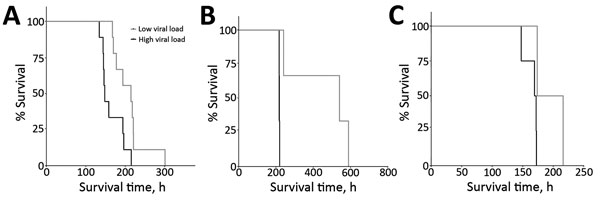Volume 23, Number 8—August 2017
Research
Clinical Laboratory Values as Early Indicators of Ebola Virus Infection in Nonhuman Primates
Figure 3

Figure 3. Survival curves, stratified by high (>9 log10 RNA copies/mL) and low (<9 log10 RNA copies/mL) viral loads, for each of 3 nonhuman primate models of Ebola virus disease. A) Comparison of survival on postinoculation day 5 for rhesus macaques infected with the Kikwit strain of Ebola virus (EBOV). Median survival time was 148.0 hours for macaques with high viral loads (n = 9) and 214.6 hours for macaques with low viral loads (n = 9). Comparison of the 2 survival curves yielded a statistically significant value (p = 0.010 by Mantel-Cox log-rank test). B) Comparison of survival on postinoculation day 7 for rhesus macaques infected with the Makona strain of EBOV. Median survival time was 217.7 hours for macaques with high viral loads (n = 3) and 540.4 hours for macaques with low viral loads (n = 3). Comparison of the 2 survival curves yielded a statistically significant value (p = 0.025 by Mantel-Cox log-rank test). C) Comparison of survival on postinoculation day 5 for cynomolgus macaques infected with the Kikwit strain of EBOV. Median survival time was 170.6 hours for macaques with high viral loads (n = 4) and 195.0 hours for macaques with low viral loads (n = 2). Comparison of the 2 survival curves yielded a nearly statistically significant value (p = 0.074 by Gehan–Breslow–Wilcoxon test).